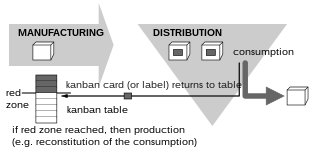 W
W5S is a workplace organization method that uses a list of five Japanese words: seiri (整理), seiton (整頓), seisō (清掃), seiketsu (清潔), and shitsuke (躾). These have been translated as "sort", "set in order", "shine", "standardize" and "sustain". The list describes how to organize a work space for efficiency and effectiveness by identifying and storing the items used, maintaining the area and items, and sustaining the new order. The decision-making process usually comes from a dialogue about standardization, which builds understanding among employees of how they should do the work.
 W
WIn manufacturing, the term andon refers to a system which notifies managerial, maintenance, and other workers of a quality or processing problem. The alert can be activated manually by a worker using a pullcord or button or may be activated automatically by the production equipment itself. The system may include a means to pause production so the issue can be corrected. Some modern alert systems incorporate audio alarms, text, or other displays; stack lights are among the most commonly used.
 W
WInventory or stock is the goods and materials that a business holds for the ultimate goal of resale.
 W
WJust-in-time (JIT) manufacturing, also known as just-in-time production or the Toyota Production System (TPS), is a methodology aimed primarily at reducing times within the production system as well as response times from suppliers and to customers. Its origin and development was mainly in Japan, largely in the 1960s and 1970s and particularly at Toyota.,
 W
WKaizen is a concept referring to business activities that continuously improve all functions and involve all employees from the CEO to the assembly line workers. Kaizen (改善)(かいぜん) is the Sino-Japanese word for "improvement". Kaizen also applies to processes, such as purchasing and logistics, that cross organizational boundaries into the supply chain. It has been applied in healthcare, psychotherapy, life coaching, government, and banking.
 W
WKanban (看板) is a scheduling system for lean manufacturing and just-in-time manufacturing (JIT). Taiichi Ohno, an industrial engineer at Toyota, developed kanban to improve manufacturing efficiency. Kanban is one method to achieve JIT. The system takes its name from the cards that track production within a factory. For many in the automotive sector, kanban is known as the "Toyota nameplate system".
 W
WA Kanban board is one of the tools that can be used to implement Kanban to manage work at a personal or organizational level.
 W
WManagement System is a socio-technical system that leverages the cumulative knowledge of management practitioners and evidenced based research from the past 130 years. The system was developed by DoD components in partnership with industry experts and academic researchers and builds off of the US Department of Wars version 1.0 open source management system - Training Within Industry.
 W
WA shadow board is a device for organizing a set of tools; the board defines where particular tools should be placed when they are not in use. Shadow boards have the outlines of a work station's tools marked on them, allowing operators to identify quickly which tools are in use or missing. The boards are commonly located near the work station where the tools are used. Shadow boards are often used in the manufacturing environment to improve a facility's lean six sigma capabilities.
 W
WValue-stream mapping, also known as "material- and information-flow mapping", is a lean-management method for analyzing the current state and designing a future state for the series of events that take a product or service from the beginning of the specific process until it reaches the customer. A value stream map is a visual tool that displays all critical steps in a specific process and quantifies easily the time and volume taken at each stage. Value stream maps show the flow of both materials and information as they progress through the process.